October 7, 2012
by Carole Zangari -

For this week’s video, we head back to the Aaron W. Perlman Center at Cincinnati Children’s Hospital Medical Center for a wonderful video about getting started with AAC symbols. We know you will enjoy this overview of some of the most popular AAC symbols and the lovely examples they share. –
Filed under: Video of the Week
Tagged With: AAC system, choice making, getting started, implementation ideas, intervention, symbol
September 30, 2012
by Carole Zangari -
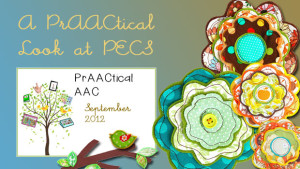
This week, we’re heading back to the Autism and Tertiary Behavior Supports Project of the Kansas Technical Assistance Network. They have two wonderful videos by Lori Chambers on Picture Exchange Communication System (PECS). – You can view an overview of this approach here: Part 1 and Part 2 . Also, look for the handouts that accompany these videos. –
Filed under: Video of the Week
Tagged With: ASD, implementation ideas, intervention, PECS, reinforcement
September 23, 2012
by Carole Zangari -
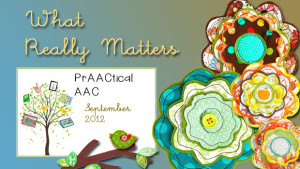
We love this video that reminds us that technology is a beautiful thing, but the real power is in communication. Kudos to the AAC team at Thames Valley Children’s Centre for this wonderful reminder of three important things. Language learning happens through good teaching, not the mere provision of equipment. Verbal expression without technology is not only powerful but awesome. Literacy is something we should prioritize for all learners. As we prepare for AAC awareness month, enjoy this lovely conversation.
Filed under: Video of the Week
Tagged With: intervention, language
September 9, 2012
by Carole Zangari -
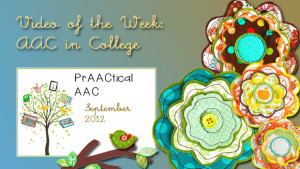
It’s a beautiful Sunday here in South Florida and we are ready to turn our faces to the sun. Nothing makes us smile more than hearing directly from people who communicated effectively with their AAC systems. Enjoy this panel presentation of young adults who are using AAC in college.
Filed under: Video of the Week
Tagged With: college
September 2, 2012
by Carole Zangari -
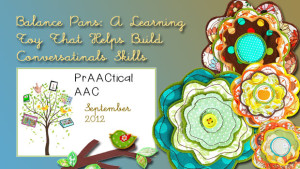
We’ve been thinking a lot lately about the social skills of some of our AAC friends who are not quite fitting in the way that they would like. SLPs frequently work on social interaction skills with learners on the ASD spectrum, but it’s not something that we always think about with learners who have cerebral palsy, apraxia, or other developmental disabilities. – The idea of using a balance scale as a metaphor for balance in conversational turns is intriguing and one we’ve explored a bit. In this video from Autism Teaching Strategies, Joel Shaul demonstrates the strategy and discusses it relative to turn-taking (Click here for Part 1 and click here for the second video). That makes sense for a lot of learners who don’t respond to non-obligatory situations as well as they could. – We’ve also used it for helping people with AAC see how their utterances compare to... [Read More...]
Filed under: Video of the Week
Tagged With: Conversation, intervention
August 26, 2012
by Carole Zangari -
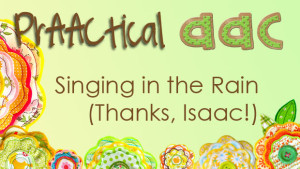
By tradition, we post an AAC-related video on Sundays. Today, we’re thinking that it’s time for a song, and those who attended ISAAC 2012 know that there’s nothing like the songs sung using AAC. This video features an adaptation of a classic folk song, If I Had a Hammer, performed by the talented Snoopi Botten. Direct Link to Video: https://www.youtube.com/watch?v=XG0kXjXu2Yo
Filed under: Video of the Week
Tagged With: SGD, singing, song
August 26, 2012
by Carole Zangari -
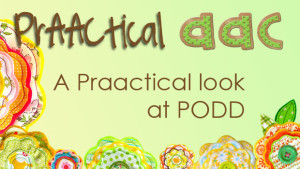
This week, we return to the team at the Autism and Tertiary Behavior Supports Project of the Kansas Technical Assistance Network. They have two wonderful videos by Jane Goetz and Lori Chambers on Pragmatically Organized Dynamic Displays. You can view ‘It’s All About the Interaction,” Part 1 and Part 2 . Also, look for the handout and tip sheet that accompanies these videos. –
Filed under: Video of the Week
Tagged With: ASD, cerebral palsy, communication, communication book, developmental disability, intervention, partner assisted scanning, PODD, resources
August 19, 2012
by Robin Parker -
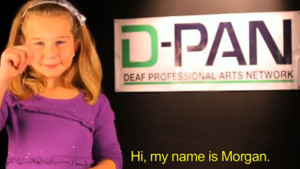
We All need friends. Especially in school. This video can’t help but inspire us to be be involved in helping our students make friends this school year.
Filed under: Video of the Week
Tagged With: Friends, sign language, song
August 12, 2012
by Carole Zangari -
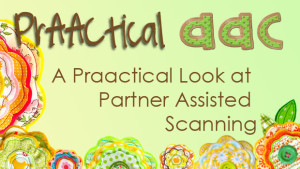
Awhile back, we listed a few strategies that seem to be under-utilized in AAC. One of those is partner assisted scanning, a strategy we love for its boundless flexibility. In this week’s video we turn to the Cincinnati Children’s Hospital Medical Center’s Aaron W. Perlman Center. Tune in for a clear description of the strategy and lots of wonderful examples. You can learn more from them here. – –
Filed under: Video of the Week
Tagged With: access, partner assisted scanning
August 5, 2012
by Carole Zangari -
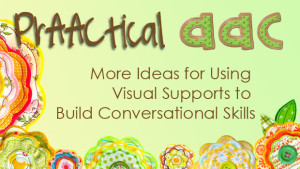
Cohesion is a tough concept for many of our learners who are developing their AAC skills and struggling to build relationships. In this week’s featured video, Joel Shaul, from Autism Teaching Strategies, discusses how to use two metaphors for building cohesive conversations. One is the idea of links in a chain and the other is the girders of a building. Of course, we are big fans of the use of visual supports whenever we talk and teach. — Although the focus here is learners with ASD, we’ve used this and similar strategies many kinds of learners. Hope you enjoy this informative video. – – – –
Filed under: Video of the Week
Tagged With: Conversation, intervention, resources, visual supports









